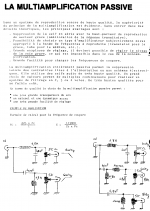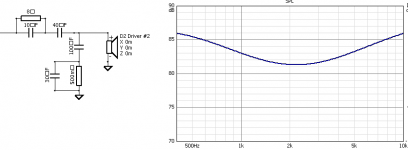Input - output impedance
Well the input impedance of the power amps matter since I am driving them with a tube preamp. Imagine driving two amps of 10 kOhm with a preamp of 1kOhm output impedance !!!
BTW I am reading an article on Audioasylum concerning pllxo. I'll post a link soon.
I haven't done it but see no reason why you can't. The output impedance of the pre and the input impedance of the power amp don't matter, as long as they're flat with frequency. That's usually the case. You can design a passive network to give any response you want and drop it between, but the cost will always be gain. As long as you have enough excess gain to overcome the loss of the network (and sufficient headroom so it doesn't clip), it should work fine. There are various books on passive network design- if you search around you might find a copy of the old Sams Photofact book, Passive Audio Network Design by Howard M. Tremaine somewhere for cheap. IMO, and good text from Terman on up would be a good start on understanding this stuff.
Well the input impedance of the power amps matter since I am driving them with a tube preamp. Imagine driving two amps of 10 kOhm with a preamp of 1kOhm output impedance !!!
BTW I am reading an article on Audioasylum concerning pllxo. I'll post a link soon.
I don't want to step on the OP's thread, but I am working on a PLLXO now and am looking for input. Sounds like some of the guys who have weighed in here might be interested. Please see this thread:
http://www.diyaudio.com/forums/showthread.php?p=1909222#post1909222
Thanks
Kirk
http://www.diyaudio.com/forums/showthread.php?p=1909222#post1909222
Thanks
Kirk
If the source and load impedance are fixed and known you can design any kind of passive filter you want to, that is it can have any desired FR. The problem arises if either the source or load impedance the filter sees changes. Then the filter FR characteristics will change. This is why active filters are better. They isolate the passive components between known fixed source and load impedances, that is active gain stages being tubes or transistors. Changes to the signal source or load impedance have no effect on the isolated stage where the FR is altered.
passive bi amping french style
Hello,
I would like to use a 12db passive filter between pre amp and power supply. The pre amp is tube based with a tango output transformer giving a 150 ohm output impedance. Above 600 hertz there will be a tube power amp which will have a 470Kohm input impedance so probably no problem there.
In my other set up i did start using a Virtue sensation tripath based integrated amp, recently did switch to a battery power supply with 40AH batteries.
Turning up the volumecontrol will turn it into a power amp with 50K ohm input input impedance. There used to be one with a Gary Dodd tube buffer which will give it a 100K ohm value.
There is a new Virtue out there but it will have 15 or 18K ohm input impedance depending on if you jumper out the pot.
There is a set of Ice block amps available which has the tube buffer built in. BUT it has an absolute overkill on power to use on my altec 104db system.
Maybe i could raise the input impedance on the new model using a cinemag ( which one? ) transformer. Loosing some power there is okay I will probably go for battery power on the new virtue amp if i decide to go for that one.
Not sure if they will match well with my voice of the theatre with 16ohm woofers instead of the usual 8 ohm ones. They dont need power but still can be difficult to drive well. Usual tube amps will do well.
Any thoughts are welcome to make my choice easier.
Sincere greetings, edward
P.s i can have the new virtue boards without a case so i can just built a big chassis containing the batteries, the filter for the lower frequencies ( or better to place it in the preamp?)
Hello,
I would like to use a 12db passive filter between pre amp and power supply. The pre amp is tube based with a tango output transformer giving a 150 ohm output impedance. Above 600 hertz there will be a tube power amp which will have a 470Kohm input impedance so probably no problem there.
In my other set up i did start using a Virtue sensation tripath based integrated amp, recently did switch to a battery power supply with 40AH batteries.
Turning up the volumecontrol will turn it into a power amp with 50K ohm input input impedance. There used to be one with a Gary Dodd tube buffer which will give it a 100K ohm value.
There is a new Virtue out there but it will have 15 or 18K ohm input impedance depending on if you jumper out the pot.
There is a set of Ice block amps available which has the tube buffer built in. BUT it has an absolute overkill on power to use on my altec 104db system.
Maybe i could raise the input impedance on the new model using a cinemag ( which one? ) transformer. Loosing some power there is okay I will probably go for battery power on the new virtue amp if i decide to go for that one.
Not sure if they will match well with my voice of the theatre with 16ohm woofers instead of the usual 8 ohm ones. They dont need power but still can be difficult to drive well. Usual tube amps will do well.
Any thoughts are welcome to make my choice easier.
Sincere greetings, edward
P.s i can have the new virtue boards without a case so i can just built a big chassis containing the batteries, the filter for the lower frequencies ( or better to place it in the preamp?)
Attachments
sorry for my english, i build a pllxo with a c of 20pf highpass without resistor, a 33 pf for bandpass without resistor but with a inductor of 0,296mh directly on midrange speaker and a lowpass with a 100kohm r1 and c of 20nf . the sound is very natural
best regard
i live in palermo
best regard
i live in palermo
Worth noting that if the amplifier input bias current is non-linear with input voltage then you will generate intermodulation distortion by relying on the input impedance of the amplifier as part of the filter.(ideally you use the input impedance of the amp as part of your PLLXO)
It's better practice to add an additional resistor that is at least 1 order of magnitude smaller than the amplifier's input impedance so the amplifiers impedance doesn't affect the filter imo.
edit: old thread, but still valid tip.
Can the crossovers in a 2-way speaker be used for PLLXO?
This is what I'm working with: https://sites.google.com/site/undefinition/classix-ii
This is what I'm working with: https://sites.google.com/site/undefinition/classix-ii
Can the crossovers in a 2-way speaker be used for PLLXO?
Not the passive XO inside. The impedance values that a PLLXO deals with are dramatically different than those in a speaker.
One can do an LC PLLXO but the size of the inductors needed usually puts it out of reach, hence the more typical use of RC filters.
dave
I wasn't aware of the specific limitation of the inductors, but I didn't think it would work.
I've read the t-line PLLXO article, as well as Art Ludwig's article. It sounds like it becomes very difficult to go above 2nd order filters w/ RC.
Given that the xo in my speaker employs a 4th order for the tweeter, does that disqualify this project from a PLLXO? Or at least mean I'm less likely to get good results?
I've read the t-line PLLXO article, as well as Art Ludwig's article. It sounds like it becomes very difficult to go above 2nd order filters w/ RC.
Given that the xo in my speaker employs a 4th order for the tweeter, does that disqualify this project from a PLLXO? Or at least mean I'm less likely to get good results?
To go higher than 2nd order you would need to go LC. RC PLLXO is really at its best in its 1st order form, and the speaker needs to be specifically designed for their use.
Consider that the inductors in your passive XO are typically looking into 4 or 8 ohms. An amplifier typically has input Z of 10-100k ohms. That means inductors on the order of 1,000-10,000 times as large as in your passive XO (caps are that same multiplier smaller).
Both of these were designed with 1st order PLLXO in mind.
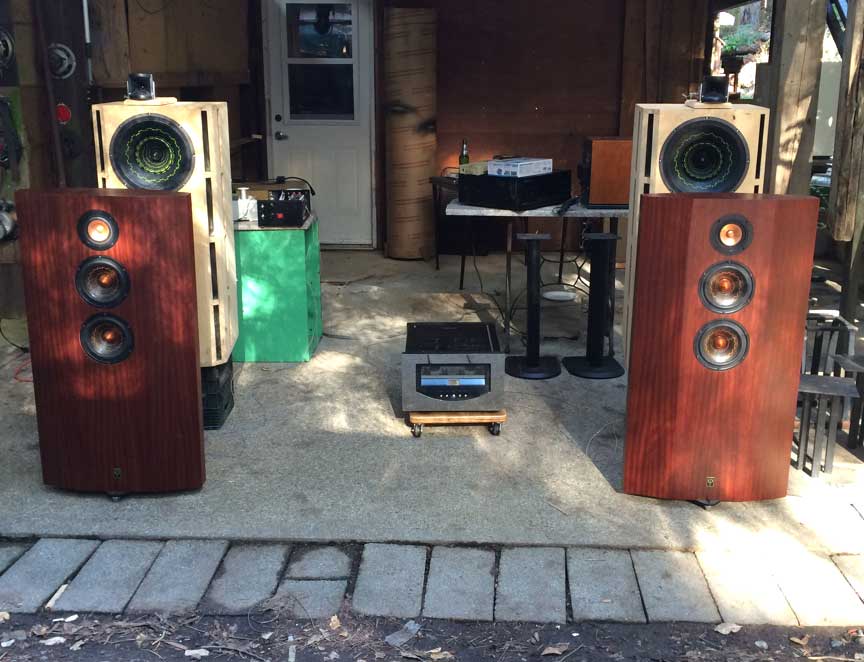
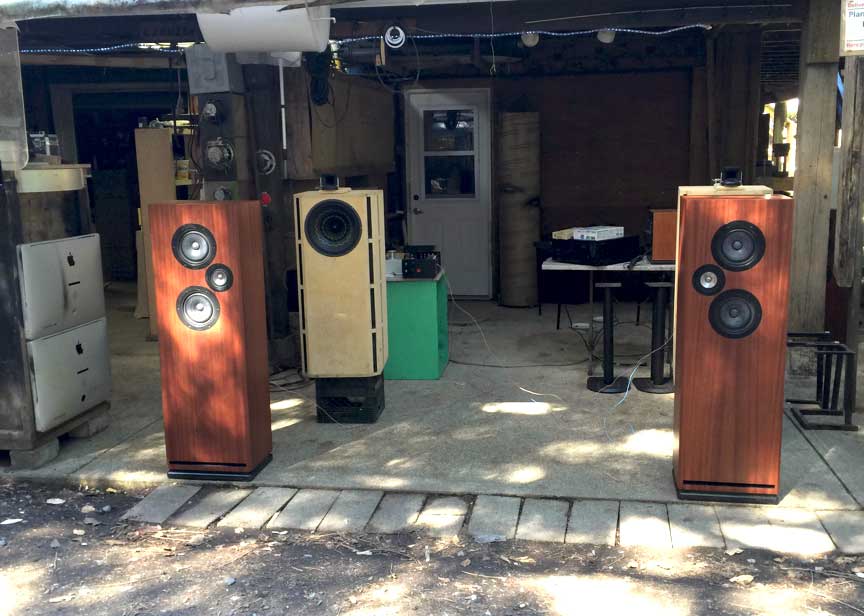
We have even taken this to the point of taking a 4-channel Sure Class D amp and building switchable PLLXO into the box (can be seen sitting on the corner of the green stand). That experiment showed its weakness in the Class-D amps ability to do the top — it got clobbered by a couple other amps brought to diyFEST.
dave
Consider that the inductors in your passive XO are typically looking into 4 or 8 ohms. An amplifier typically has input Z of 10-100k ohms. That means inductors on the order of 1,000-10,000 times as large as in your passive XO (caps are that same multiplier smaller).
Both of these were designed with 1st order PLLXO in mind.


We have even taken this to the point of taking a 4-channel Sure Class D amp and building switchable PLLXO into the box (can be seen sitting on the corner of the green stand). That experiment showed its weakness in the Class-D amps ability to do the top — it got clobbered by a couple other amps brought to diyFEST.
dave
This is the only commercailly available LC PLLXO that i know of: XM46 Passive Line Level Crossover Network, PLLXO, 24 dB/oct
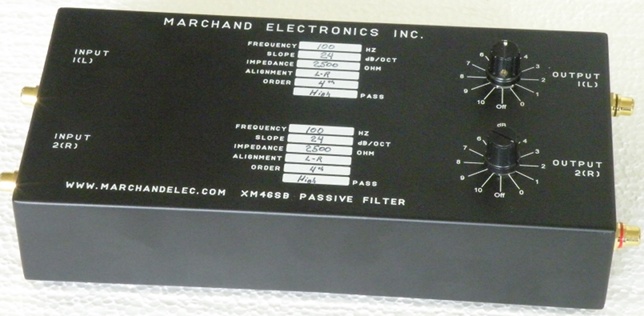
The filters work into a 5kΩ load so you need to have a pre-amp with some grunt and a low output impedance.
dave
The filters work into a 5kΩ load so you need to have a pre-amp with some grunt and a low output impedance.
dave
You can achieve any crossover slope and/or equalisation with a passive circuit using reistors and capacitors. A full crossover can get complex without the help of a circuit simulator. It needs to fit appropriately between the driving and driven impedances and will represent a loss in level, so noise and gain need to be considered.
If you understand your amp there is more than one place you can apply such a filter so you can break it up into pieces. Practically speaking, the PLLXO is well suited to simple portions of a crossover so you could dispense with just a part of your passive speaker level crossover and try to get most of the benefits along the way.
If you understand your amp there is more than one place you can apply such a filter so you can break it up into pieces. Practically speaking, the PLLXO is well suited to simple portions of a crossover so you could dispense with just a part of your passive speaker level crossover and try to get most of the benefits along the way.
An RC PLLXO over 1st order will have a “droopy” response.
On the high pass (at least) each successive R to ground should be 10x the one that proceeds it.
Because of this any RC PLLXO is practically limited to 2nd order. Of course if you buffer each RC you can get very complex but it is no longer a passive XO.
dave
On the high pass (at least) each successive R to ground should be 10x the one that proceeds it.
Because of this any RC PLLXO is practically limited to 2nd order. Of course if you buffer each RC you can get very complex but it is no longer a passive XO.
dave
Passive Line Level is usually somewhat unique in that it runs at a higher impedance making chokes larger, and more susceptible to Cw so either more challenging to build or less available. Of course if you can get (or repurpose) them then you should. At any rate at least the source and loads are usually resistive and are surrounded by gain.
So if you find yourself up against using only capacitors and resistors you have to get creative. Here's an example, getting sharper curves is possible too if you can work at it. Don't be afraid to trade off a little gain in the process and optimise it back later.
P.S. in a real PLLXO the load will not be a speaker, it will be a resistance. I just happened to use a speaker simulator to make my point
So if you find yourself up against using only capacitors and resistors you have to get creative. Here's an example, getting sharper curves is possible too if you can work at it. Don't be afraid to trade off a little gain in the process and optimise it back later.
P.S. in a real PLLXO the load will not be a speaker, it will be a resistance. I just happened to use a speaker simulator to make my point
Attachments
- Status
- This old topic is closed. If you want to reopen this topic, contact a moderator using the "Report Post" button.
- Home
- Loudspeakers
- Multi-Way
- Passive line level x-over - CAN IT BE DONE?
